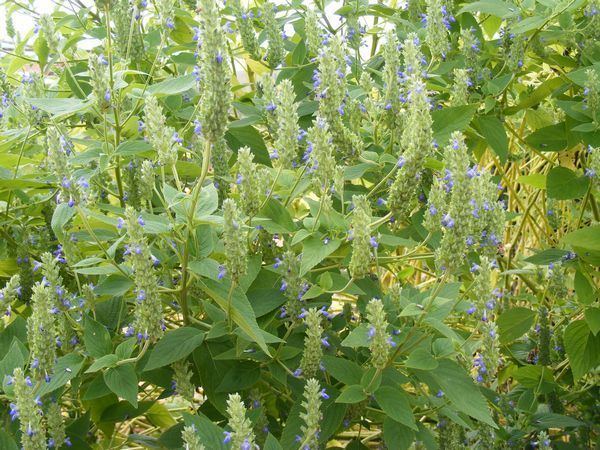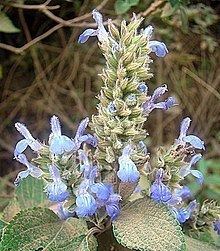Species S. hispanica | ||
Similar Flax, Seed, Chia seed, Sesame, Smoothie | ||
Salvia hispanica, commonly known as chia (/ˈtʃiːə/), is a species of flowering plant in the mint family, Lamiaceae, native to central and southern Mexico and Guatemala. The sixteenth-century Codex Mendoza provides evidence that it was cultivated by the Aztec in pre-Columbian times and economic historians say it may have been as important as maize as a food crop. It was given as an annual tribute by the people to the rulers in 21 of the 38 Aztec provincial states.
Contents
- Salvia hispanica chia seed
- Etymology
- Description
- Seeds
- Nutrient content and food uses
- Preliminary health research
- Drug interactions
- Mesoamerican usage
- Climate and growing cycle length
- Seed yield and composition
- Soil seedbed requirements and sowing
- Fertilization and irrigation
- Genetic diversity and breeding
- Diseases and crop management
- Decorative and novelty uses
- References

Ground or whole chia seeds are still used in Paraguay, Bolivia, Argentina, Mexico, and Guatemala for nutritious drinks and food.

Salvia hispanica chia seed
Etymology
The word "chia" is derived from the Nahuatl word chian, meaning oily.
S. hispanica is one of two plants known as "chia"; Salvia columbariae is commonly known as "golden chia".
Description

Chia is an annual herb growing up to 1.75 metres (5.7 feet) tall, with opposite leaves that are 4–8 cm (1.6–3.1 in) long and 3–5 cm (1.2–2.0 in) wide. Its flowers are purple or white and are produced in numerous clusters in a spike at the end of each stem. Chia is hardy from USDA Zones 9–12. Many plants cultivated as S. hispanica are in fact Salvia lavandulifolia.
Seeds

Chia is grown commercially for its seed, a food rich in omega-3 fatty acids since the seeds yield 25–30% extractable oil, including α-linolenic acid. The composition of the fat of the oil may be 55% ω-3, 18% ω-6, 6% ω-9, and 10% saturated fat.
Typically, chia seeds are small ovals with a diameter of approximately 1 mm (0.039 in). They are mottle-colored with brown, gray, black, and white. The seeds are hydrophilic, absorbing up to 12 times their weight in liquid when soaked. While soaking, the seeds develop a mucilaginous coating that gives chia-based beverages a distinctive gel texture.

Chia (or chian or chien) has mostly been identified as Salvia hispanica L. Today, chia is grown and consumed commercially in its native Mexico and Guatemala, as well as Bolivia, Argentina, Ecuador, Nicaragua, and Australia. New patented varieties of chia have been developed in Kentucky for cultivation in northern latitudes of the United States.
Nutrient content and food uses

A 100-gram serving of chia seeds is a rich source (20% or more of the Daily Value, DV) of thiamine and niacin (54% and 59%, respectively), and a moderate source of riboflavin and folate (14% and 12% DV, respectively). The same amount of chia seeds contains high amounts (48–130% DV) of the dietary minerals calcium, iron, magnesium, manganese, phosphorus and zinc (table).
Chia seeds may be added to other foods as a topping or put into smoothies, breakfast cereals, energy bars, granola bars, yogurt, tortillas, and bread. In 2009, the European Union approved chia seeds as a novel food, allowing chia to be 5% of a bread product's total matter. Chia seed (tokhm-e-sharbatī, meaning "beverage seed") is used to prepare a sharbat (cold beverage) in Iran.
They also may be made into a gelatin-like substance or consumed raw. The gel from ground seeds may be used to replace the egg content in cakes while providing other nutrients, and is a common substitute in vegan baking.
Preliminary health research
Although preliminary research indicates potential health benefits from consuming chia seeds, this work remains sparse and inconclusive. In a 2015 systematic review, most of the studies did not demonstrate a statistically significant effect of chia seed consumption on cardiovascular risk factors in humans.
Drug interactions
No evidence to date indicates consuming chia seeds has adverse effects on or interacts with prescription drugs.
Mesoamerican usage
S. hispanica is described and pictured in the Mendoza Codex and the Florentine Codex, sixteenth-century Aztec codices created between 1540 and 1585. Both describe and picture S. hispanica and its use by the Aztec. The Mendoza Codex indicates that the plant was widely cultivated and given as tribute in 21 of the 38 Aztec provincial states. Economic historians suggest that it was a staple food that was used as widely as maize.
Aztec tribute records from the Mendoza Codex, Matrícula de Tributos, and the Matricula de Huexotzinco (1560)—along with colonial cultivation reports and linguistic studies—detail the geographic location of the tributes, and provide some geographic specificity to the main S. hispanica-growing regions. Most of the provinces grew the plant, except for areas of lowland coastal tropics and desert. The traditional area of cultivation was in a distinct area that covered parts of north-central Mexico, south to Nicaragua. A second and separate area of cultivation, apparently pre-Columbian, was in southern Honduras and Nicaragua.
Climate and growing cycle length
The growing cycle length for chia varies based on location and is influenced by elevation. For production sites located in different ecosystems in Bolivia, Argentina, and Ecuador, growing cycles are between 100–150 days in duration. Accordingly, commercial production fields are located in the range of 8–2200 m altitude across a variety of ecosystems ranging from tropical coastal desert, to tropical rain forest, and inter-Andean dry valley. In northwestern Argentina, a time span from planting to harvest of 120–180 days is reported for fields located at elevations of 900–1500 m.
S. hispanica is a short-day flowering plant, indicating its photoperiodic sensitivity and lack of photoperiodic variability in traditional cultivars, which has limited commercial use of chia seeds to tropical and subtropical latitudes until 2012. Now, traditional domesticated lines of S. hispanica can be grown in temperate zones at higher latitudes in the United States. In Arizona or Kentucky, seed maturation of traditional chia cultivars is stopped by frost before or after flower set, preventing seed harvesting. Advances in plant breeding during 2012, however, led to development of new early-flowering chia genotypes proving to have higher yields in Kentucky.
Seed yield and composition
Seed yield varies depending on cultivars, mode of cultivation, and growing conditions by geographic region. For example, commercial fields in Argentina and Colombia vary in yield range from 450 to 1250 kg/ha. A small-scale study with three cultivars grown in the inter-Andean valleys of Ecuador produced yields up to 2300 kg/ha, indicating that favorable growing environment and cultivar interacted to produce such high yields. Genotype has a larger effect on yield than on protein content, oil content, fatty acid composition, or phenolic compounds, whereas high temperature reduces oil content and degree of unsaturation, and raises protein content.
Soil, seedbed requirements, and sowing
The cultivation of S. hispanica requires light to medium clay or sandy soils. The plant prefers well-drained, moderately fertile soils, but can cope with acid soils and moderate drought. Sown chia seeds need moisture for seedling establishment, while the maturing chia plant does not tolerate wet soils during growth.
Traditional cultivation techniques of S. hispanica involve soil preparation by disruption and loosening followed by seed broadcasting. In modern commercial production, a typical sowing rate of 6 kg/ha and row spacing of 0.7–0.8 m usually is applied.
Fertilization and irrigation
S. hispanica can be cultivated under low fertilizer input, using 100 kg nitrogen per hectare or in some cases, no fertilizer is used.
Irrigation frequency in chia production fields may vary from none to eight irrigations per growing season, depending on climatic conditions and rainfall.
Genetic diversity and breeding
The wide range of wild and cultivated varieties of S. hispanica are based on seed size, shattering of seeds, and seed color. Seed weight and color have high heritability, with a single recessive gene responsible for white color.
Diseases and crop management
Currently, no major pests or diseases affect chia production. Essential oils in chia leaves have repellant properties against insects, making it suitable for organic cultivation. Virus infections, however, possibly transmitted by white flies may occur. Weeds may present a problem in early development of the chia crop until its canopy closes, but because chia is sensitive to most commonly used herbicides, mechanical weed control is preferred.
Decorative and novelty uses
During the 1980s in the United States, the first substantial wave of chia seed sales was tied to Chia Pets. These "pets" come in the form of clay figures that serve as a base for a sticky paste of chia seeds; the figures then are watered and the seeds sprout into a form suggesting a fur covering for the figure. About 500,000 chia pets a year are sold in the U.S. as novelties or house plants.
